Paul Gustave Alexandre Froment, 1815 - 1865
by Brian Stevenson
last updated February, 2025
Gustave Froment was a technological genius, a creative and highly-skilled manufacturer of precisely engineered apparatus. Froment contributed to numerous fields, in particular the development of electrical motors. He built the pendulums with which Léon Foucault was able to demonstrate the rotation of Earth. He manufactured precision measuring instruments, such as theodolites, compasses, and astronomical devices, as well as clocks, gyroscopes, and pantographs. Their exactness was enabled, in part, by his application of electric motors to cutting and marking. One such device used a diamond knife that cut into glass, capable of dividing one millimeter into a thousand equal parts.
Froment combined those skills to make novelty items for the microscope: he was one of the first, if not the first, person to produce slides with microscopical writing (Figures 1, 2, 5, and 6). These are first mentioned in association with the 1851 International Exhibition in London, where he presented a microscopical engraving dedicated to Queen Victoria and Prince Albert (Figure 5). Froment’s stunning works inspired William Peters, who worked on money engraving for the Bank of England, to produce a comparable machine. Peters’ device was donated to the Microscopical Society of London and used by its president, Robert J. Farrants, to produce a number of slides with microscopically-engraved writings. William Webb, then a clerk, displayed a pantograph of his devising at the 1851 Exhibition, and undoubtedly witnessed Froment’s work. Webb subsequently built a new pantograph to produce microscopical writings, which he sold on a relatively large scale.
Microengravings by Froment are rarely found in collections or at auction. This may be due to their not being a major product of a skilled mechanical engineer who manufactured precise instruments. Or, it may be a matter of loss through the years or lack of recognition. I acquired the Froment slide shown in Figure 1 in a large mix of slides and microscope apparatus from France, of which the seller did not recognize anything special about the small green-and-black slide. May we all be so fortunate!
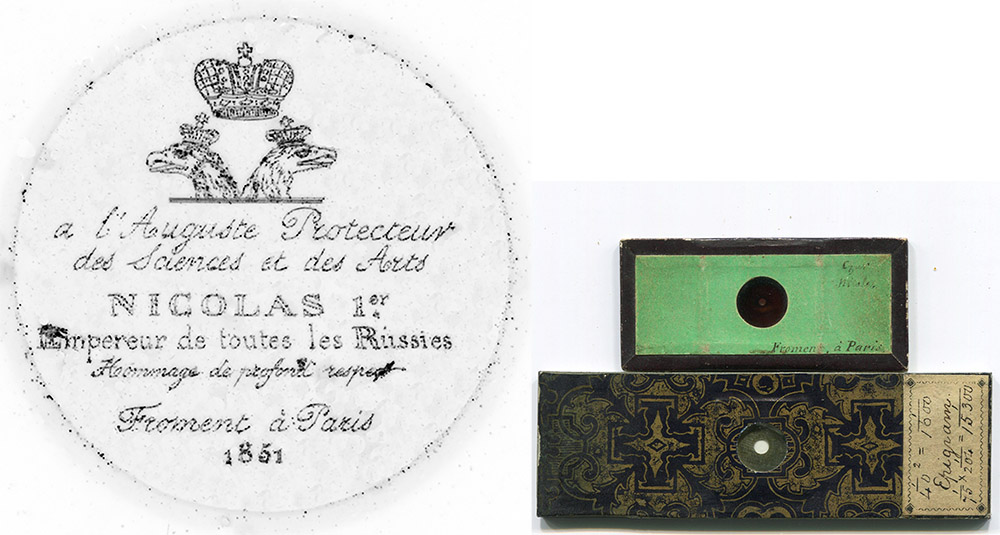
Figure 1.
An 1851 microengraving by Gustave Froment, honoring Czar Nicholas I of Russia. The reason for this choice of subject is not clear. For size comparison, the slide is shown adjacent to a standard-sized 1x3 slide (which was made by R.J. Farrants). The engraved image was photographed with a 10x objective lens and C-mounted digital camera. The engraving is too fine to be photographed with brightfield, and so was imaged with phase contrast, then the image inverted. Large dust motes were erased digitally.

Figure 2.
Comparisons of microengravings by Gustave Froment, Robert Farrants, and William Webb. All were photographed using the same microscope, 10x objective lens, and camera, using phase contrast lighting. The composite image was produced with all images having the same relative size. Large dust motes were erased digitally.
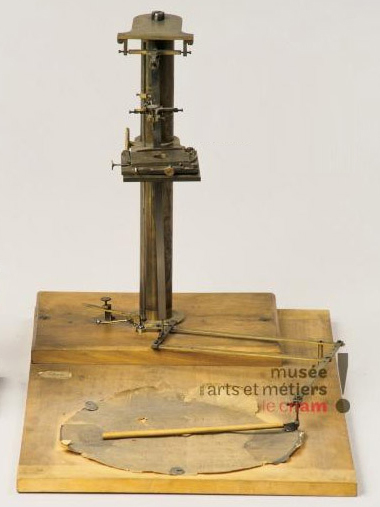
Figure 3.
Froment’s reducing machine for microscopical writing. Adapted for nonprofit, educational purposes from an image available from Musee des Arts et Metiérs, Paris.
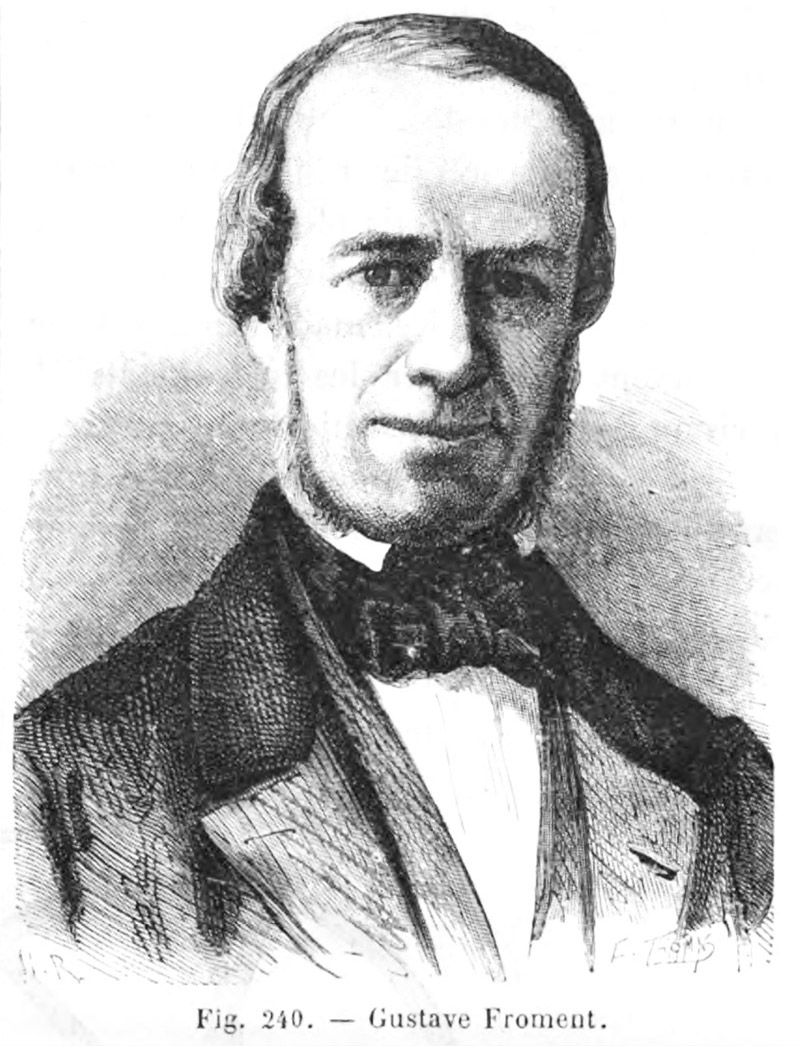
Figure 4.
Gustave Froment. Adapted from “Les Merveilles de la Science ou Description Populaire des Inventions Modernes”, 1868.
Little has been found of Froment’s personal life. The 1897 Livre du Centenaire de l'Ecole Polytechnique states that Froment was born in Paris on March 3, 1815. His family was originally from Reims, with a long tradition of working in the mechanical arts. In 1852, the Bulletin de la Société d'Encouragement pour l'Industrie Nationale listed Gustave as “Froment fils, ingénieur en instruments de précision”, implying that his father operated a similar business. Gustave Froment was probably related to the artist Eugene Froment-Delamel (1820-1900) - the two shared the address 5 Rue de Ménilmontant during the 1850s. The parents of Eugene, and of Gustave if they were brothers, were named Nicholas and Victoire Valevee Delormel Froment.
Gustave attended Lycée Louis-le-Grand, and then Ecole Polytechnique. As a young teenager, he reportedly built a precise clock from wire, cardboard, string and other materials, with a heavy dictionary as the gravity-driven engine and a wooden ruler and another book serving as the pendulum.
At the age of 18, in 1833, Froment saw an apparatus by Antoine-Hippolyte Pixii (1808 - 1835), in which a horseshoe magnet was caused to revolve by an electromagnet. That inspired him to build his first electric motor. He continued to develop that tool through the remainder fo his short life.
Also during his school years, Froment learned the art and chemistry of photography. An 1835 photograph by him is shown in Figure 10.
Upon graduation from Ecole Polytechnique, he moved to Manchester, England, to continue his studies of mechanical engineering. He returned to Paris in 1839, and opened a shop to produce steam engines. That failed, so he instead turned to the manufacture of apparatus for studies of physics and other scientific endeavors.
In 1843, he produced the first dial telegraph in France. At the 1844 Exposition of the Products of Industry of France, he displayed a number of “instruments de physique”.
An 1847 Paris directory placed Froment’s business at 24 Rue du Bouloi. He relocated to 5 Rue de Ménilmontant by 1850, and to 85 Rue Notre-Dame-des-Champs by 1857.
Most of us have seen a “Foucault pendulum” in action (Figure 11). Usually a large device in an open public space, they are sensitive to the Earth’s rotation, such that each sweep of the pendulum shifts clockwise or counter-clockwise by an angle proportional to the hemisphere and latitude. The first of these, only two meters high, was produced by Froment and used by Foucault on January 8, 1851 in the first experiment that demonstrated rotation of the Earth. By command, the pair installed another, larger pendulum in the Paris Panthéon, which was a tremendous hit with the public (Figure 11).
Also in 1851, the great International Exhibition was held in London. Among his entries, Froment presented at least one microscopical engraving (Figure 5). Minute features such as the crown, lion, and unicorn indicate both a precise diamond knife and tightly engineered reduction machinery. The perfect circles imply a drawing aid. Froment is known to have integrated electric motors into his manufacturing apparatus - such an aid would facilitate precise cutting depths.
Froment’s exhibit inspired Peters and Webb to replicate Froment’s engraving machine. Farrants reported in 1855, “Most of the Members of the Microscopical Society are undoubtedly acquainted with Nobert's lines, and have probably considered with astonishment the wonderfully-minute movements which must have been effected in producing them. Very beautiful specimens of microscopic writing, also by a foreigner, Froment, of Paris, have, I believe, also been exhibited in this room. I am not aware that any account has been published of the manner in which the results are attained. It is satisfactory to be able to state that these interesting productions of our continental neighbours have been at least equalled by means of a machine, entirely contrived and principally constructed by a gentleman of our own country, Mr. Peters, the banker, who is also a distinguished member of the Microscopical Society: he makes no secret of the manner in which his marvellous specimens are produced: on asking leave to lay before this Society an account of his wonder working machine, and the manner of using it, permission was at once most liberally given; and that the description may be the more intelligible, he has kindly allowed the machine itself to be placed on the table. Being thus enabled to point to the machine, the need for accurate drawings of it, is in a great measure superseded; still, some figures have been prepared with a view to render the details of its construction more easy of comprehension: these, however, are diagrams merely, and have no pretension to be considered drawings of the instrument. The machine had its origin in the following circumstance: Mr. Peters, having been shown some microscopic writing, executed, I believe, by Froment, of Paris, expressed his belief that he could produce writing as small; this opinion was received with extreme incredulity; Mr. Peters, however, feeling confident of the sufficiency of his plan, determined to test it by actual trial: the result is a machine capable of executing and recording movements of almost inconceivable minuteness: with it, in its present condition, Mr. Peters has written “The Lord's Prayer,” (in the ordinary writing character without abbreviation or contraction of any kind) in a space not exceeding the one hundred and fifty thousandth, 1-150,000th of a square inch”. Both Peters/Farrants and Webb displayed examples of their microscopical writings at the 1862 London Exhibition. In 1862, Froment exhibited measuring devices such as theodolites (Figure 14), which won a medal, but did not show anything related to microscopy.
Dionysius Lardner wrote in 1856 of a visit to Froment, which included a personalized gift, “I now come to notice a sort of microscopic engraving, which, though it is at once the most curious and difficult, has not, so far as I am informed, had as yet any directly useful application. Regarded, however, as an example of mechanical ingenuity and skill, and as an artistic tour de force of the highest order, it is full of interest. However much we may admire the production of the micrometric scales and microscopic test-plates described above, there is nothing in them to excite surprise, save the precision which is combined with such extreme minuteness. To draw a series of parallel lines of regulated length and uniform intervals, is a problem, to the solution of which it is easy to conceive that finely constructed mechanism can be adapted; but when it is proposed to delineate objects and characters, in which no such regularity prevails, and, in tracing which, the point of the graving tool must pursue a course determined by conditions, which obviously cannot be represented by any kind of mechanism, and to accomplish which it must be guided, directly or indirectly, by the hand, a problem of quite another, and far more difficult order, is presented: such, however, is the curious and complicated problem for which Mr. Froment, already named, has found a solution. This eminent artist has succeeded in producing manuscripts and drawings, engraved upon glass, on a scale of minuteness in no degree less surprising, though far more difficult of execution than the test plates of Mr. Nobert. … Mr. Froment wrote for me, in less than five minutes, within a circle of glass, the 40th of an inch in diameter … the sentence which, when magnified in its linear, 120, and in its superficial dimensions, 14400 times, presented the appearance shown in (Figure 6). On the occasion of the Great Exhibition in 1851, the characters and figures shown in (Figure 5) were engraved by Mr. Froment”.
A small number of microscopes are known that are engraved with Froment’s name (Figure 9). The Museum of the History of Science (Oxford) attributes the construction of their horizontal Froment-signed microscope to Vincent Chevalier. While Froment was undoubtedly capable of making microscopes, they are not mentioned as being among his regular products. It is reasonable, however, that he may have had some microscopes on hand for customers in his shop, or would custom-order microscopes when requested.
Among Froment’s many honors were the 1857 Volta Prize, for his developments to electric motors, and appointment as both Knight and Officer of the Legion of Honor. A street in Paris, Rue Froment, was named after him.
Gustave Froment died in February, 1865, at the age of 49.
An obituary stated, “La mort vient de ravir à la science un des physiciens les plus distingués. Paul-Gustave Froment était un savant modeste, un esprit pénétrant et ingénieux, qui a consacré sa vie aux applications de la science pratique, et surtout à la construction des instruments de précision destinés à l'astronomie, à la navigation. L'un des premiers, il s'occupa des moteurs électro-magnétiques; il a appliqué lui-même ses machines électro-motrices à ses appareils à diviser, notamment pour graduer les limites des cercles destinés à la mesure des angles. C'est à lui que M. Léon Foucault a confié l'exécution des appareils à l'aide desquels il démontre le mouvement de rotation de la terre; c'est encore à lui que l'on doit d'ingénieux perfectionnements dans la construction des télégraphes électriques. Dès sa jeunesse, Froment avait montre une grande aptitude pour la mécanique ... Il inventa une machine qui enregistrait le nombre de pas qu'il faisait par jour. Plus tard, il parvint à diviser un millimètre en mille parties égales, à écrire des devises visibles seulement au microscope, dans des espaces ayant à peine un millimètre de diamètre. Mais, ce qui faisait le caractère dominant de cette belle intelligence, c'était une nature droite, obligeante, dévouée à la science. II est impossible de dire toutes les inventions qu'il a perfectionnées, tous les précieux conseils qu'il a si libéralement donnés. Personne n'a plus que lui aidé à réaliser des conceptions scientifiques: c'est qu'il unissait à un même degré la science théorique et la science pratique.” (“Death has just robbed science of one of the most distinguished physicists. Paul-Gustave Froment was a modest scientist, a penetrating and ingenious mind, who devoted his life to the applications of practical science, and especially to the construction of precision instruments for astronomy and navigation. One of the first, he dealt with electro-magnetic motors; he himself applied his electro-motor machines to his apparatuses to divide, notably to graduate the limits of the circles intended for the measurement of the angles. It was to him that M. Leon Foucault entrusted the execution of the apparatus by means of which he demonstrated the rotational movement of the earth; it is to him that we owe ingenious improvements in the construction of electric telegraphs. Since his youth, Froment had shown a great aptitude for mechanics .... He invented a machine that recorded the number of steps he took every day. Later, he managed to divide a millimeter into a thousand equal parts, to write visible currencies only under the microscope, in spaces barely a millimeter in diameter. But what made the dominant character of this beautiful intelligence, it was a right nature, obliging, devoted to science. It is impossible to say all the inventions he has perfected, all the precious advice he has so liberally given. Nobody more than helped him to realize scientific conceptions: it was that he united to the same degree theoretical science and practical science.).
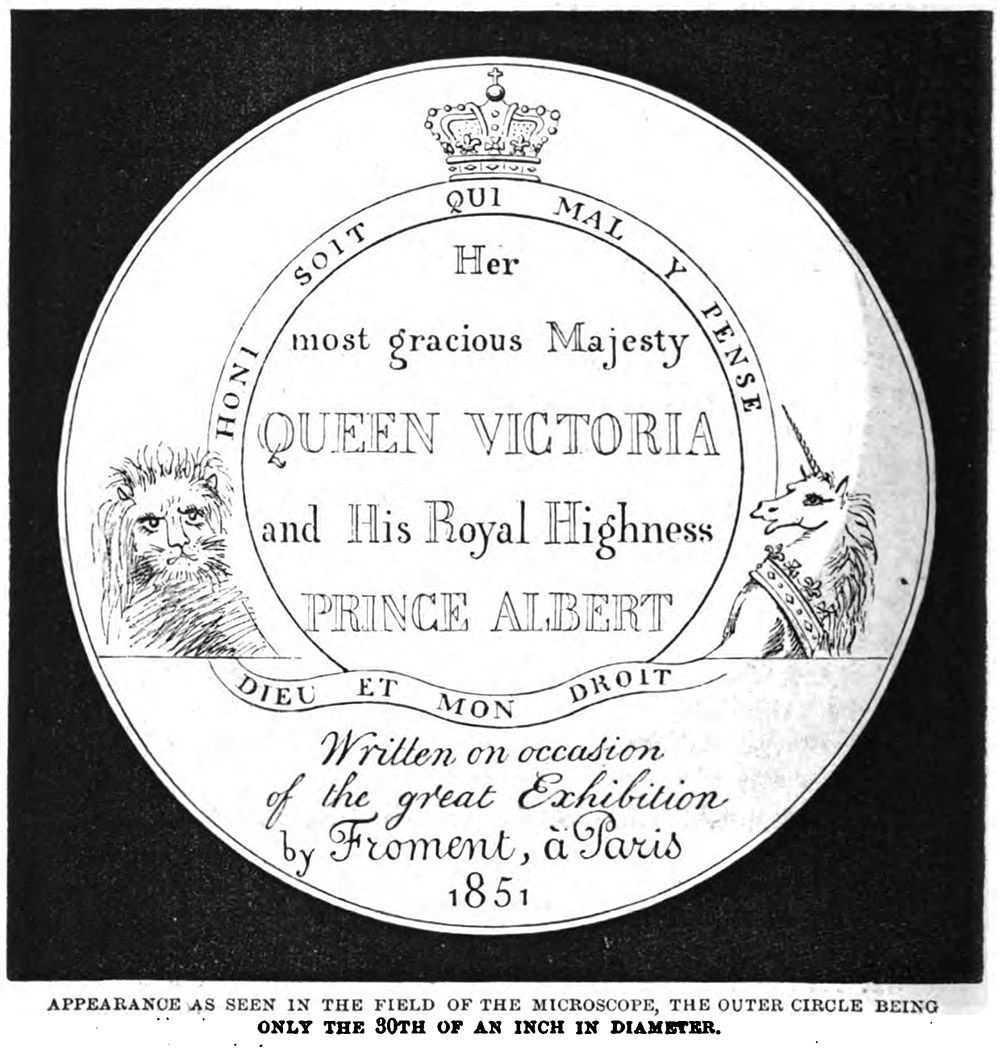
Figure 5.
An illustration of the micro-engraving that was displayed by Froment in 1851. Adapted from Lardner, 1856.
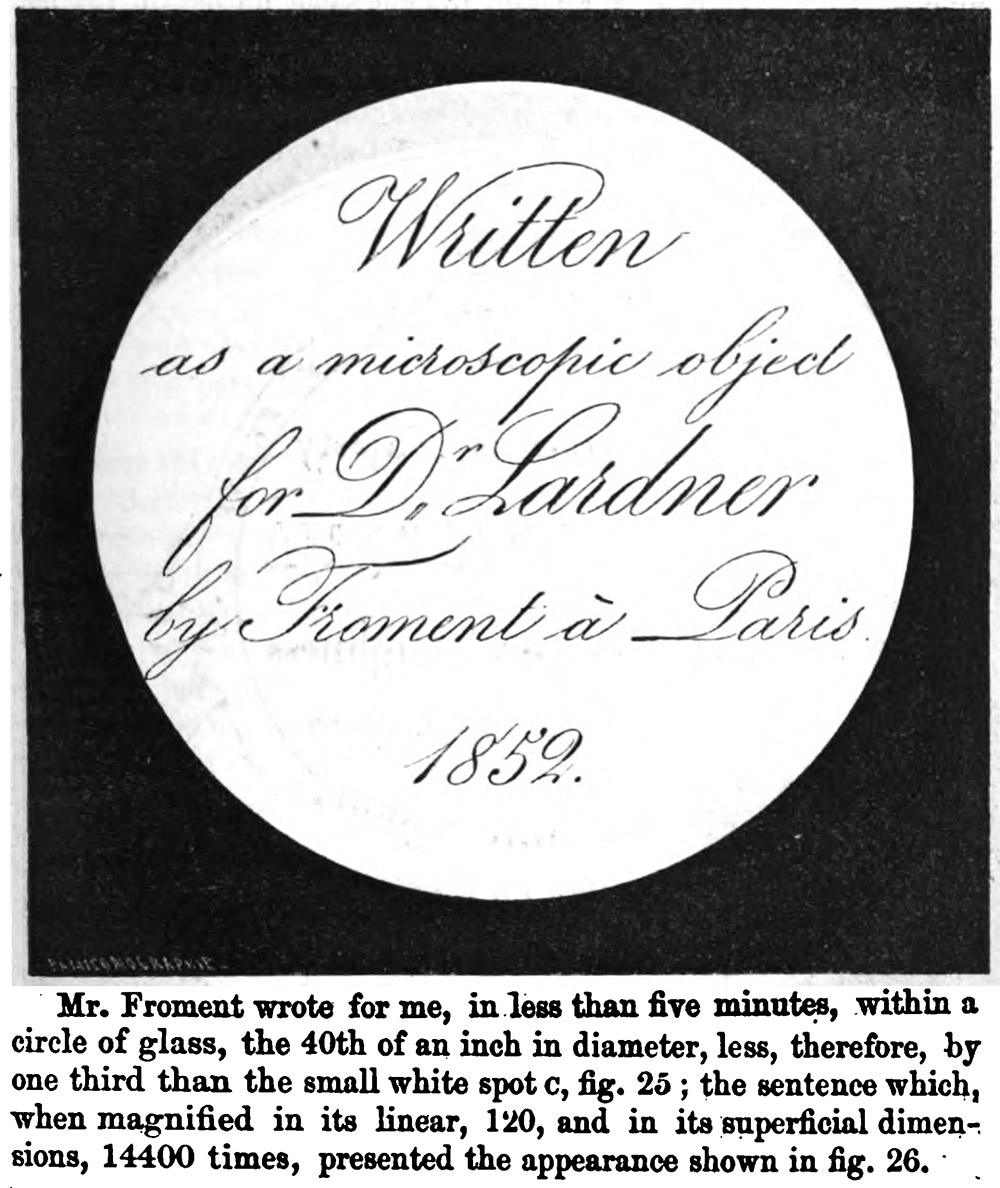
Figure 6.
An illustration of an 1852 micro-engraving by Froment. Adapted from Lardner, 1856.
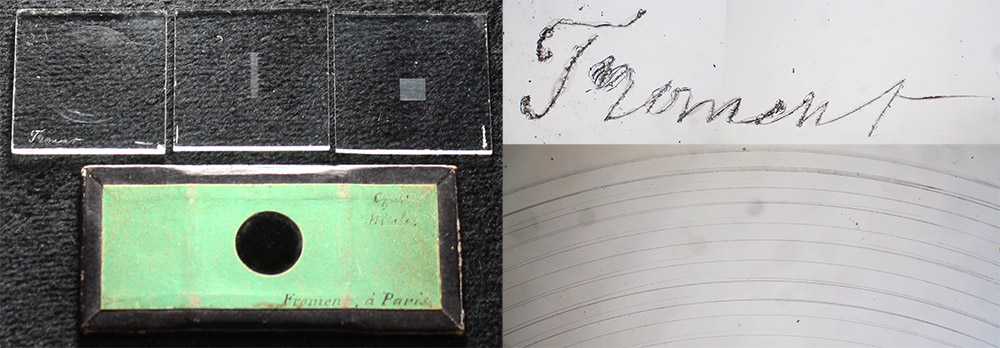
Figure 7.
The box of microscope apparatus that included the Froment slide shown in Figure 1 also included several precisely-cut microscopic lines and circles. One of them, a 2cm square of glass with a series of concentric circles, bears Froment’s engraved signature (left image, leftmost slide). Two additional, unsigned glasses with precise grids are also shown. Brightfield photomicrographs of Froment’s signature and the circles are shown to the right, both photographed with a 3.5x objective lens and C-mounted digital camera.
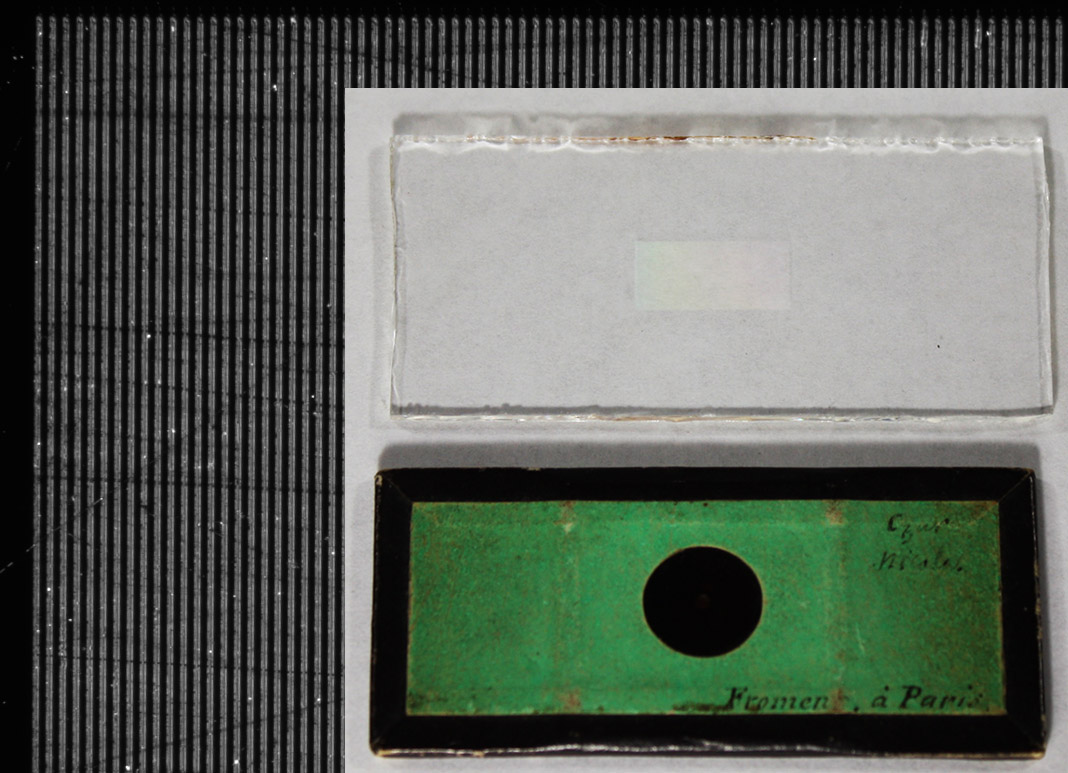
Figure 8.
A larger glass slide with a micro-engraved series of lines that accompanied the Froment-signed slides. The set of lines appears as a rainbow-hued rectangle in the inset photograph. Although unsigned, its quality of production and circumstance of discovery suggest that it was produced by Froment. A phase-contrast photomicrograph is shown in the background, photographed with a 10x objective lens and C-mounted digital camera.
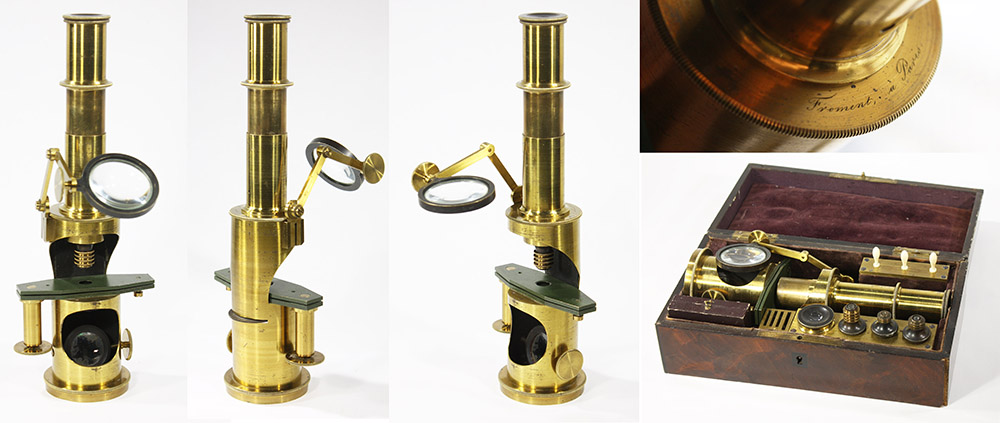
Figure 9A.
A drum style compound microscope that is engraved with Froment’s name. Two other such microscopes are known to me, suggesting that this was a standard pattern of Froment's. Unique features suggest that either Froment built them in-house or had them custom-made by a wholesale manufacturer.
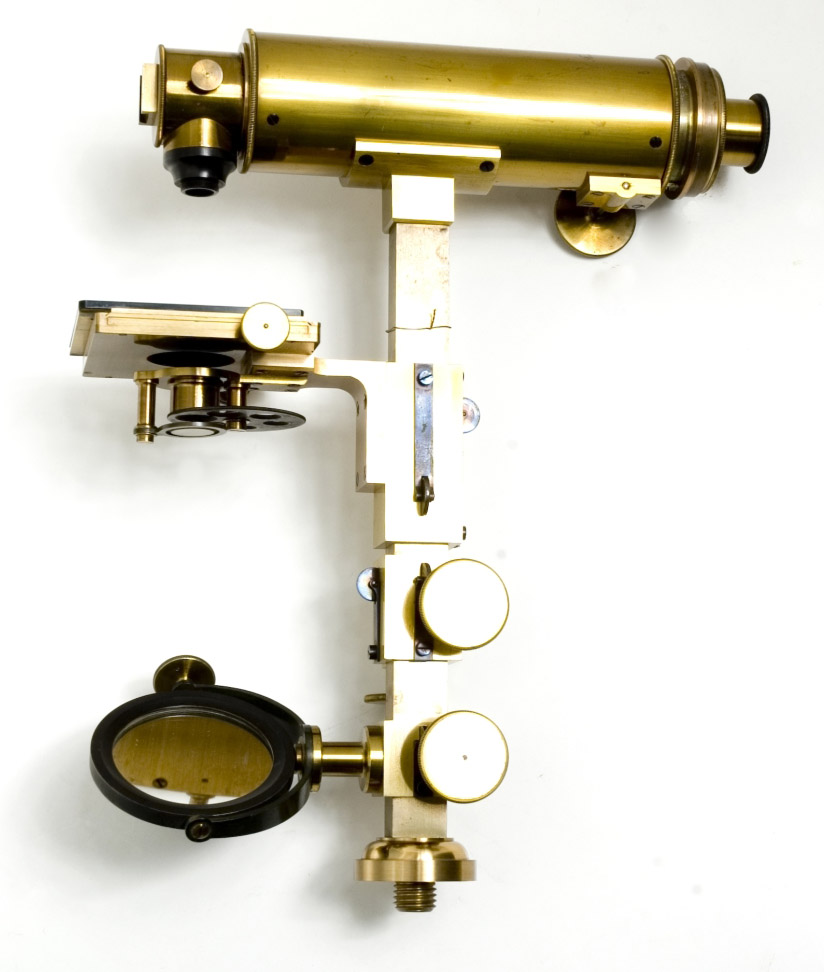
Figure 9B.
A horizontal microscope that is engraved with Froment’s name. Its construction is attributed to Vincent Chevalier Adapted for nonprofit, educational purposes from the Museum of the History of Science and The Musee des Arts et Metiérs. The Billings Collection holds an identical microscope that is also signed by Froment.
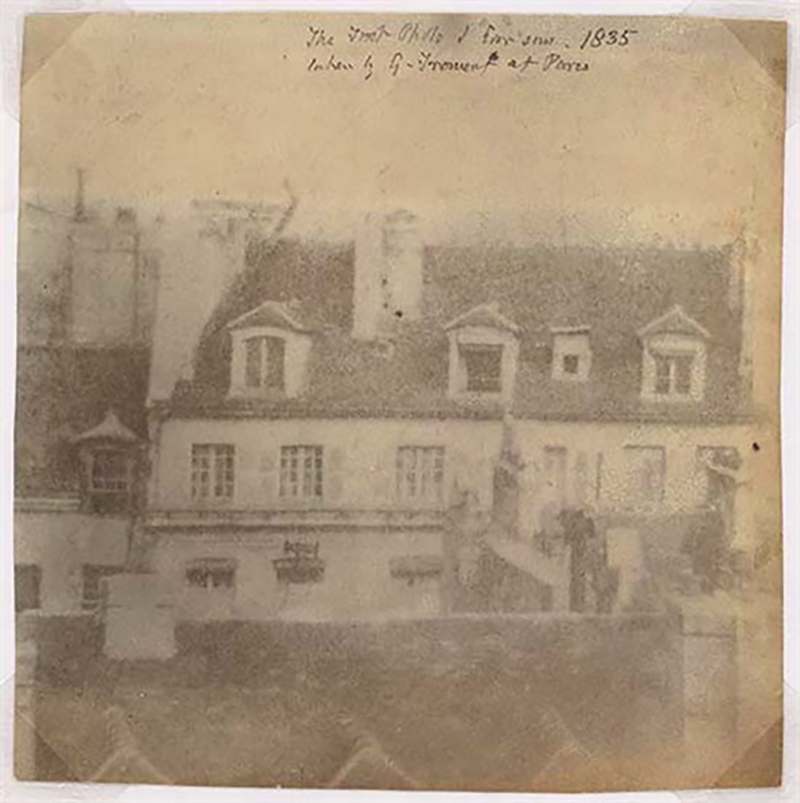
Figure 10.
An 1835 photograph that is attributed to Froment. Adapted for nonprofit, educational purposes from an image available from the National Library of Scotland, https://www.nls.uk/collections/photographs/paris-rooftops .
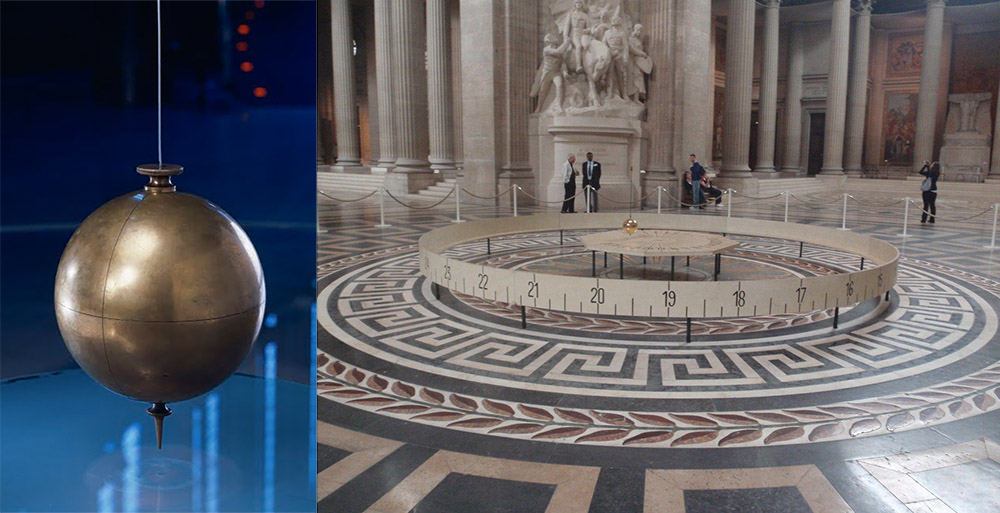
Figure 11.
(Left) The pendulum that was built by Froment in 1851 for exhibition in the Panthéon of Paris. It is currently held in The Musee des Arts et Metiérs.
(Right) A replica of the Foucault-Froment pendulum, in the Panthéon.
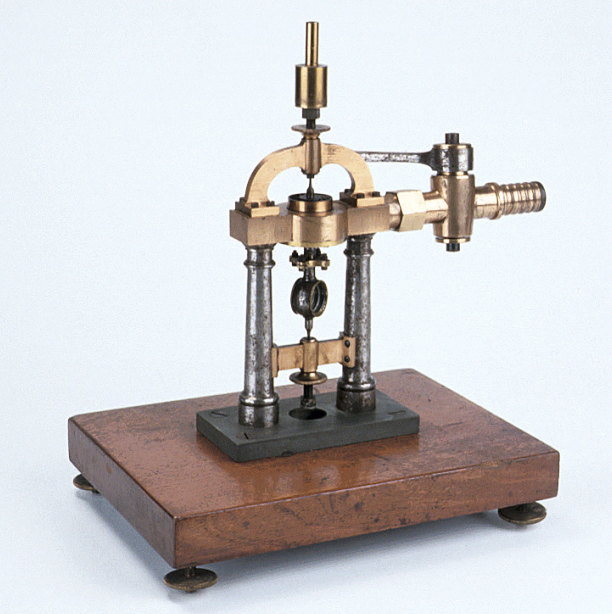
Figure 12.
A ca. 1855 apparatus by Froment that was used by Leon Foucault to determine the speed of light. Adapted for nonprofit, educational purposes from an image provided by the Museum of the History of Science.
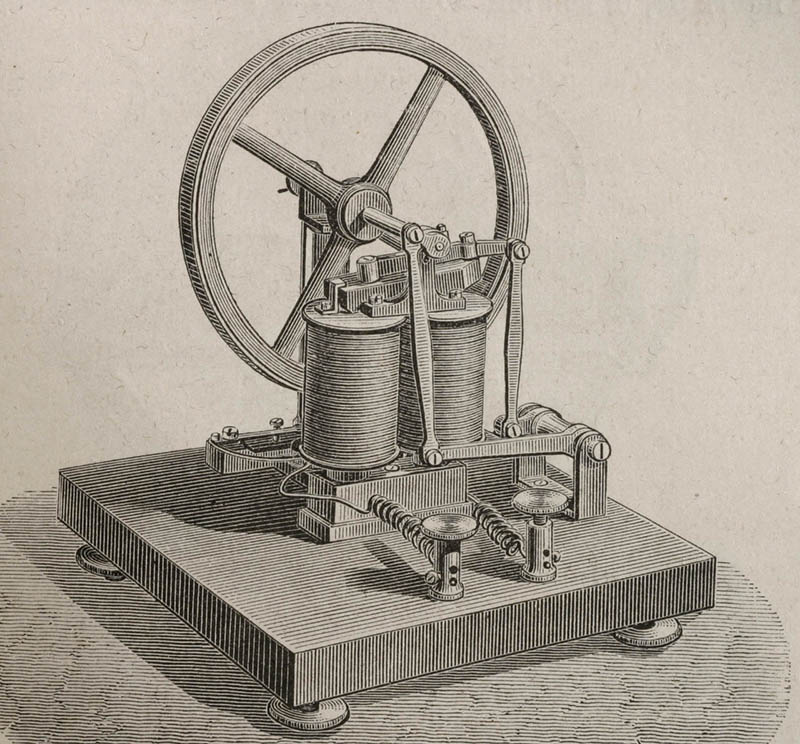
Figure 13.
An 1845 engraving of a Froment electric motor.
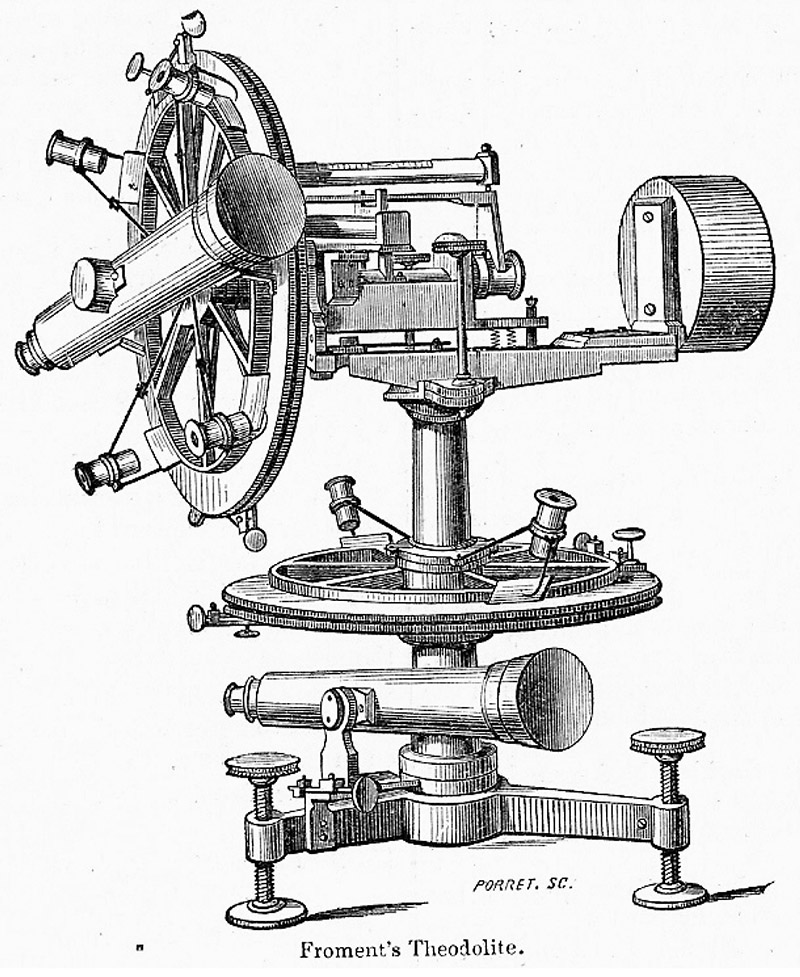
Figure 14.
An illustration of a theodolite that was displayed by Froment at the 1862 London International Exhibition.
Resources
Aczel, Amir D. (2006) Léon Foucault: His life, times, and acheivements, in The Pendulum: Scientific, Historical, Philosophical and Educational Perspectives, edited by M. Matthews, C.F. Gauld, and A. Stinner, Springer, Dordrecht, Netherlands, pages 171-184
Barenboim, G. and J.A. Oteo (2013) One pendulum to run them all, European Journal of Physics, Vol. 34, page 1049
The Billings Microscope Collection (1974) Second edition, Armed Forces Institute of Pathology, Washington, D.C., page 37, figure 70
Brenni, Paolo (1862) La Science Française au Crystal Palace, pages 255-265
Bulletin de la Société d'Encouragement pour l'Industrie Nationale (1852) “Froment fils, ingénieur en instruments de précision, rue Ménilmontant, 5, Paris”, Vol. 51, page 85
Didot Freres (1847) “Froment, instruments de physique, Bouloi, 24”, Annuaire Général du Commerce et de l'Industrie, page 119
Didot Freres (1852) “Froment (G.), instruments de physique, Ménilmontant, 5”, Annuaire Général du Commerce et de l'Industrie
Didot Freres (1857) “Froment (G.), instruments de physique, N.-D.-des-Champs, 85”, Annuaire Général du Commerce et de l'Industrie
Didot Freres (1864) “Froment (G.), instruments de physique, N.-D.-des-Champs, 85”, Annuaire Général du Commerce et de l'Industrie, page 284
Explication des Ouvrages de Peinture, Sculpture, Gravure, Lithographie, et Architecture des Artistes Vivants, Exposés au Palais-Royal le 1er Avril 1852 (1852) “Froment-Delormel (Eugène), né à Paris, élève de M. Amaury-Duval. Rue Ménilmontant, 5”, page 94
Farrants, R.J. (1855) An account of Mr. Peter's machine for microscopic writing, Quarterly Journal of Microscopical Science, Vol. 3, pages 55-63
Figuier, Louis (1868) Les Merveilles de la Science ou Description Populaire des Inventions Modernes, Furne, Jouvet, & Co., Paris, pages 85-184, 385-404, and 405-422, Gustave Froment’s picture is on page 393
France vital records, accessed through ancestry.com
Glaeser, Ernest (1878) Froment (Gustave-Alexandre), Biographie Nationale des Contemporains, Vol. 1, Glaeser et Cie., Paris, page 270
Greenslade, Thomas B. (accessed November, 2018) Instruments for Natural Philosophy: Froment Motors, http://physics.kenyon.edu/EarlyApparatus/Electric_Motors/Froment_Motor/Froment_Motor.html
Journal of the Franklin Institute (1859) New dividing engine by M. Froment, Series 3, Vol. 37, pages 283-284
Lardner, Dionysius (1856) The Museum of Science and Art, Vol. 6, Walton and Maberly, London, pages 53 and 72-74
Laussedat, A. (1897) Froment (Paul-Gustave), Livre du Centenaire de l'Ecole Polytechnique
National Library of Scotland (accessed November, 2018) https://www.nls.uk/collections/photographs/paris-rooftops
Rapport du Jury Central sur les Produits (1844) “Froment - Instruments de physique”, Vol. 3, page 761
Revue de l'Instruction Publique (1865) Obituary of Paul-Gustave Froment, page 748
Stoelwinder, Anton (accessed November, 2018) Early electric motors, http://www.earlyelectricmotors.com/motors/replica-first-electric-motor-froment














